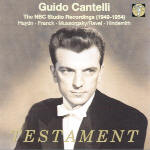Magnificent! This set contains the hugely talented Guido Cantelli’s complete studio recordings with the NBC Symphony, and what a pity that there are so few of them. His Haydn may not be textually up to date (the slow movement begins tutti, for example, and not with solo strings), but it has both classical poise and sinewy strength, especially in the minuet and finale. Cantelli’s Franck D minor Symphony ranks with Monteux’s in combining high-voltage drama with interpretive taste and instrumental clarity. Cantelli executes tricky passages such as the transitions between tempos in the first movement, and the return of the symphony’s principal themes in the finale in their various transformations, with organic coherence (and the sound is good stereo). The Mussorgsky was RCA’s response to Kubelik’s stunning Mercury Living Presence recording with the Chicago Symphony, and it’s every bit as fine. The NBC may not have quite the Chicago orchestra’s amplitude of sound, but Cantelli inspired his players to some pretty impressive feats of individual and collective virtuosity. His concluding “Great Gate of Kiev” offers an almost unequalled combination of grandeur and forward momentum.
The highpoint of this set, though, must be Cantelli’s Mathis der Maler Symphony. This piece held a special place in his repertoire (indeed, the New York Philharmonic is about to publish a 1956 performance in which Leonard Bernstein replaces Cantelli immediately following the Italian conductor’s tragic death in an airplane crash), and Toscanini’s designated heir plays it like no one else. The performance teems with characterful detail: the wonderful blast of horns through the rest of the brass at the end of the first movement; the legato treatment of the second movement’s main theme, notes held for their full values, which only adds to the music’s sadness; the superbly sculpted string recitatives at the opening of the finale; and the cymbal crashes that cap the final alleluias, replacing the rolls that Hindemith wrote in the score. This performance dramatically betters the composer’s own versions, and can withstand comparison to any since. All of these essential interpretations have been lovingly restored and sound marvelous for their age. Collectors of great historical recordings should snap this up without delay.
































